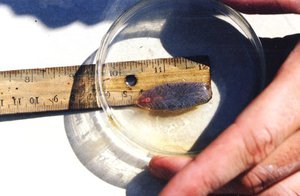Flukes: Trematoda
Human Blood Fluke (schistosoma Mansoni): Species Accounts

Physical characteristics: Female human blood flukes are thin, cylindrical, and one-half to 1 inch (1.3 to 2.5 centimeters) long. Males are a little bit shorter and thicker. Males have small spiny suckers on the mouth and belly and a wrinkled back dotted with small bumps. Females usually spend their lives attached to males. Both males and females are white.
Geographic range: Human blood flukes live in the warm regions of the world, especially South America, Africa, the Caribbean, and the Middle East.
Habitat: The larvae of human blood flukes live in freshwater snails. The adults live in veins in the abdomens of mammals such as rodents, dogs, cattle, baboons, and humans.
Diet: Human blood flukes feed on blood in the abdominal veins of their hosts.
Human blood flukes live in the warm regions of the world, especially South America, Africa, the Caribbean, and the Middle East.
Behavior and reproduction: The eggs of human blood flukes hatch in freshwater areas and develop into larvae, which follow chemical, light, and gravitational cues to find and then penetrate the soft tissues of snails. The larvae transform into another type of larvae and swim out of the snails. The larvae actively seek out the next host by targeting fatty acids in the skin. They then penetrate the skin of a secondary host, which may be a person or other mammal. Once in the host, the larvae become immature flukes, travel to the circulatory system, and travel to veins near the large intestine. Once in the veins, the flukes mature, mate, and lay eggs, many of which leave the host's body with feces. The cycle begins again when the eggs make their way into the freshwater habitat of the snail. Adult male human blood flukes usually live joined with the females, the female remaining in the male's spine-covered reproductive canal, a groove that runs along the lower surface of the body.
Human blood flukes and people: Infection with human blood flukes causes disease in humans. The condition causes abdominal pain, diarrhea, intestinal bleeding, tiredness, and a decrease in red blood cells, leaving the victim weak and vulnerable to other diseases.
Conservation status: Human blood flukes are not threatened or endangered. ∎
Additional topics
- Flukes: Trematoda - No Common Name (fasciola Hepatica): Species Accounts
- Flukes: Trematoda - Lancet Fluke (dicrocoelium Dendriticum): Species Accounts
- Other Free Encyclopedias
Animal Life ResourceJellyfish, Sponges, and Other Simple AnimalsFlukes: Trematoda - Physical Characteristics, Behavior And Reproduction, Lancet Fluke (dicrocoelium Dendriticum): Species Accounts, Human Blood Fluke (schistosoma Mansoni): Species Accounts - GEOGRAPHIC RANGE, HABITAT, DIET, FLUKES AND PEOPLE, CONSERVATIO